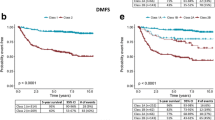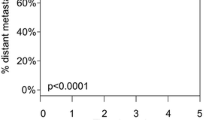Abstract
Purpose
Current histopathological staging of cutaneous melanoma is limited in predicting outcome, and complementary molecular markers are not available for prognostic assessment. The purpose of this study was to identify a quantitative gene expression score in primary melanoma and adjacent stroma that can be used in clinical routine to define, at the time of diagnosis, patient risk and need for therapy.
Methods
Expression of 92 candidate genes was quantified by RT-PCR in a training subset of 38 fresh-frozen melanomas. Correlation of gene expression with overall survival (OS) was evaluated using univariate regression analysis. Expression analysis of 11 prognostically significant genes in the complete training cohort of 91 melanomas yielded nine genes predicting outcome. Results were confirmed in a validation cohort of 44 melanomas.
Results
We identified a nine-gene signature associated with OS and distant metastasis-free survival. The signature comprised risk and protective genes and was applicable to melanoma samples across all AJCC stages in the presence of adjacent stroma. A signature-based risk score predicted OS in both the training cohort (multivariate regression analysis: p = 0.0004, hazard ratio 3.83) and the validation cohort, independently of AJCC staging. Consequently, when combining risk score and AJCC staging, patients in the AJCC intermediate-risk stages, IIA/B or IIIA, were re-classified either to low or high risk.
Conclusions
Our gene score defines patient risk and need for therapy in melanoma. The score has the potential to be utilized in clinical routine, since it is quantitative, robust, simple, and independent of AJCC stage and sample purity.



Similar content being viewed by others
References
Balch CM, Gershenwald JE, Soong SJ et al (2009) Final version of 2009 AJCC melanoma staging and classification. J Clin Oncol 27:6199–6206
Bittner M, Meltzer P, Chen Y et al (2000) Molecular classification of cutaneous malignant melanoma by gene expression profiling. Nature 406:536–540
Braeuer RR, Zigler M, Villares GJ et al (2011) Transcriptional control of melanoma metastasis: the importance of the tumor microenvironment. Semin Cancer Biol 21:83–85
Brunner G, Reitz M, Schwipper V, Tilkorn H, Lippold A, Biess B, Suter L, Atzpodien J (2008) Increased expression of the tumor suppressor PLZF is a continuous predictor of long-term survival in malignant melanoma patients. Cancer Biother Radiopharm 23:451–459
Chen H-Y, Sung-Liang Y, Chun-Houh C et al (2007) A five-gene signature and clinical outcome in non-small cell lung cancer. N Engl J Med 356:11–20
Cheng X, Shen Z, Yin L, Lu SH, Cui Y (2009) ECRG2 regulates cell migration/invasion through urokinase-type plasmin activator receptor (uPAR)/beta1 integrin pathway. J Biol Chem 284:30897–30906
Conway C, Mitra A, Jewell R et al (2009) Gene expression profiling of paraffin-embedded primary melanoma using the DASL assay identifies increased osteopontin expression as predictive of reduced relapse-free survival. Clin Cancer Res 15:6939–6946
Crowley NJ, Seigler HF (1990) Late recurrence of malignant melanoma. Analysis of 168 patients. Ann Surg 212:173–177
Fitzgerald J, Rich C, Zhou FH, Hansen U (2008) Three novel collagen VI chains, alpha4(VI), alpha5(VI), and alpha6(VI). J Biol Chem 283:20170–20180
Gimotty PA, Botbyl J, Soong SJ, Guerry D (2005) A population-based validation of the American Joint Committee on Cancer melanoma staging system. J Clin Oncol 23:8065–8075
Gould Rothberg BE, Rimm DL (2010) Biomarkers: the useful and the not so useful—an assessment of molecular prognostic markers for cutaneous melanoma. J Invest Dermatol 130:1971–1987
Hanahan D, Coussens LM (2012) Accessories to the crime: functions of cells recruited to the tumor microenvironment. Cancer Cell 20:309–322
Haqq C, Nosrati M, Sudilovsky D et al (2005) The gene expression signatures of melanoma progression. Proc Natl Acad Sci USA 102:6092–6097
Hassan MI, Waheed A, Yadav S et al (2009) Prolactin inducible protein in cancer, fertility and immunoregulation: structure, function and its clinical implications. Cell Mol Life Sci 66:447–459
Hoek KS (2007) DNA microarray analyses of melanoma gene expression: a decade in the mines. Pigment Cell Res 20:466–484
Jaeger J, Koczan D, Thiesen H-J, Ibrahim SM, Gross G, Spang R, Kunz M (2007) Gene expression signatures for tumor progression, tumor subtype, and tumor thickness in laser-microdissected melanoma tissues. Clin Cancer Res 13:806–815
Kaifi JT, Rawnaq T, Schurr PG et al (2007) Short tandem repeat polymorphism in exon 4 of esophageal cancer-related gene 2 detected in genomic DNA is a prognostic marker for esophageal cancer. Am J Surg 194:380–384
Kashani-Sabet M, Venna S, Nosrati M et al (2009) A multimarker prognostic assay for primary cutaneous melanoma. Clin Cancer Res 15:6987–6992
Katoh M, Katoh M (2007) Integrative genomic analyses on HES/HEY family: notch-independent HES1, HES3 transcription in undifferentiated ES cells, and notch-dependent HES1, HES5, HEY1, HEY2, HEYL transcription in fetal tissues, adult tissues, or cancer. Int J Oncol 31:461–466
Lacroix M (2006) Significance, detection and markers of disseminated breast cancer cells. Endocr Relat Cancer 13:1033–1067
Malesh K, Parmar B, Machin D (2004) Survival analysis, a practical approach. Wiley, Chichester, p 154
Meyer S, Fuchs TJ, Bosserhoff AK et al (2012) A seven-marker signature and clinical outcome in malignant melanoma: a large-scale tissue-microarray study with two independent patient cohorts. PLoS ONE 7:e38222
Parkin DM, Bray F, Ferlay J, Pisani P (2005) Global cancer statistics, 2002. CA Cancer J Clin 55:74–108
Pfaff Smith A, Hoek K, Becker D (2005) Whole-genome expression profiling of the melanoma progression pathway reveals marked molecular differences between nevi/melanoma in situ and advanced-stage melanomas. Cancer Biol Ther 4:1018–1029
Porter D, Weremowicz S, Chin K et al (2003) A neural survival factor is a candidate oncogene in breast cancer. Proc Natl Acad Sci USA 100:10931–10936
Ren S, Liu S, Howell P, Xi Y, Enkemann SA, Ju J, Riker AI (2008) The impact of genomics in understanding human melanoma progression and metastasis. Cancer Control 15:202–215
Riker AI, Enkemann SA, Fodstad O et al (2008) The gene expression profiles of primary and metastatic melanoma yields a transition point of tumor progression and metastasis. BMC Med Genomics 1:13
Roberts L, Bowers J, Sensinger K, Lisowski A, Getts R, Anderson MG (2009) Identification of methods for use of formalin-fixed, paraffin-embedded samples in RNA expression profiling. Genomics 94:341–348
Shentu Y, Xie M (2010) A note on dichotomization of continuous response variable in the presence of contamination and model misspecification. Stat Med 29:2200–2214
Sloan DD, Nicholson B, Urquidi V, Goodison S (2004) Detection of differentially expressed genes in an isogenic breast metastasis model using RNA arbitrarily primed-polymerase chain reaction coupled with array hybridization (RAP-array). Am J Pathol 164:315–323
Sotiriou C, Piccart MJ (2007) Taking gene-expression profiling to the clinic: when will molecular signatures become relevant to patient care? Nat Rev Cancer 7:545–553
Stewart GD, Skipworth RJ, Pennington CJ, Lowrie AG, Deans DA, Edwards DR, Habib FK, Riddick AC, Fearon KC, Ross JA (2008) Variation in dermcidin expression in a range of primary human tumours and in hypoxic/oxidatively stressed human cell lines. Br J Cancer 99:126–132
Thompson JF, Scolyer RA, Kefford RF (2005) Cutaneous melanoma. Lancet 365:687–701
Van de Vijver MJ, He YD, van’t Veer LJ et al (2002) A gene expression signature as a predictor of survival in breast cancer. N Engl J Med 347:1999–2009
Vias M, Massie CE, East P, Scott H, Warren A, Zhou Z, Nikitin AY, Neal DE, Mills IG (2008) Pro-neural transcription factors as cancer markers. BMC Med Genomics 19:17
Winnepenninckx V, Lazar V, Michiels S et al (2006) Gene expression profiling of primary cutaneous melanoma and clinical outcome. J Natl Cancer Inst 98:472–482
Zafrakas M, Petschke B, Donner A, Fritzsche F, Kristiansen G, Knüchel R, Dahl E (2006) Expression analysis of mammaglobin A (SCGB2A2) and lipophilin B (SCGB1D2) in more than 300 human tumors and matching normal tissues reveals their co-expression in gynecologic malignancies. BMC Cancer 6:88
Acknowledgments
The authors would like to thank Tamara Berger and Maryla Brode for excellent technical assistance, as well as the patients and Surgical Departments of the Skin Cancer Center Hornheide for valuable support of the melanoma biobank of the Department of Cancer Research. This work was supported by grants from the Förderverein Hornheide e.V.
Conflict of interest
We declare that we have no conflict of interest.
Author information
Authors and Affiliations
Corresponding author
Electronic supplementary material
Below is the link to the electronic supplementary material.
Rights and permissions
About this article
Cite this article
Brunner, G., Reitz, M., Heinecke, A. et al. A nine-gene signature predicting clinical outcome in cutaneous melanoma. J Cancer Res Clin Oncol 139, 249–258 (2013). https://doi.org/10.1007/s00432-012-1322-z
Received:
Accepted:
Published:
Issue Date:
DOI: https://doi.org/10.1007/s00432-012-1322-z




